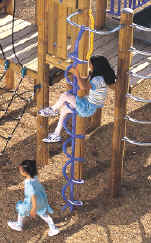 Play Components
Play Components
A play component is an element designed to generate specific opportunities for play, socialization, and learning. Play components may be manufactured or natural, and may be stand alone or part of a composite play structure. Swings, spring
riders (below), water tables, playhouses, slides, and climbers (right) are among the many different play components.
 For the purpose of the guidelines, ramps, transfer systems, steps, decks, and roofs are not considered play components. These elements are generally used to link other elements on a composite play structure. Although socialization and pretend play can occur on these elements, they are not primarily intended for play.
For the purpose of the guidelines, ramps, transfer systems, steps, decks, and roofs are not considered play components. These elements are generally used to link other elements on a composite play structure. Although socialization and pretend play can occur on these elements, they are not primarily intended for play.
When applying the play area guidelines, it is important to identify the different play experiences play components can provide.
Different "Types"
At least one of each type of play component provided at ground level in a play area must be on the accessible route.
Different "types" of play components are based on the general experience provided by the play component. Different types include, but are not limited to, experiences such as rocking, swinging, climbing, spinning, and sliding.
"Rocking" is an example of horizontal movement that can be backwards, forwards, sideways or even circular in nature.
"Sliding" is an example of rapid descent that utilizes the force of gravity.

This single play component
provides one type of play experience for multiple individuals.
The number of individuals who can play on a play component at once does not determine the quantity of play components provided in a play area. A play component can hold many children but is considered one type of play experience - or one play component - in the play area.
Examples of Sliding Types
While a spiral slide (right) provides a slightly different experience from a straight
slide (left), the primary experience - a sense of rapid descent or sliding - is common to both activities. Therefore, a spiral slide and a straight slide are considered one "type" of play experience.
Elevated Play Components
 An elevated play component is a play component that is approached above or below grade and is part of a composite play structure.
Play components that are attached to a composite play structure and that can be approached from a platform or deck area are considered elevated play components.
An elevated play component is a play component that is approached above or below grade and is part of a composite play structure.
Play components that are attached to a composite play structure and that can be approached from a platform or deck area are considered elevated play components.
This climber is considered an elevated component since it can
be approached or exited from the ground level or above grade from a platform or
deck on a composite play structure.
Ground-Level Play Components
Ground-level play components are items that can be approached and exited at ground level. For example, a child approaches a spring rider at ground level via the accessible route. The child may ride then exit directly back onto the accessible route. The activity is considered ground level because the child approaches and exits it from the ground-level route.
"Ground-level components" are approached and exited at ground level.
Ground-level play components may include items such as swings, spring riders, and panels. Freestanding slides are considered ground-level components for the purpose of these guidelines. An accessible route must connect to the ladder or steps, and to the exit of the slide. While this solution does not provide access for all children, it gives many individuals the opportunity to access play components.
Ground-level play components
may be part of a composite structure (left) or may
also be free-standing in a play area (right).
When more than one ground-level play component is required on an accessible route, the play components must be integrated.
Designers should consider the optimal layout of ground-level play components to foster interaction and socialization among all
children. Grouping all ground-level play components accessed by children with disabilities in one location does not constitute integration.
back
| next
 Play Components
Play Components For the purpose of the guidelines, ramps, transfer systems, steps, decks, and roofs are not considered play components. These elements are generally used to link other elements on a composite play structure. Although socialization and pretend play can occur on these elements, they are not primarily intended for play.
For the purpose of the guidelines, ramps, transfer systems, steps, decks, and roofs are not considered play components. These elements are generally used to link other elements on a composite play structure. Although socialization and pretend play can occur on these elements, they are not primarily intended for play.


 An elevated play component is a play component that is approached above or below grade and is part of a composite play structure.
Play components that are attached to a composite play structure and that can be approached from a platform or deck area are considered elevated play components.
An elevated play component is a play component that is approached above or below grade and is part of a composite play structure.
Play components that are attached to a composite play structure and that can be approached from a platform or deck area are considered elevated play components. 
